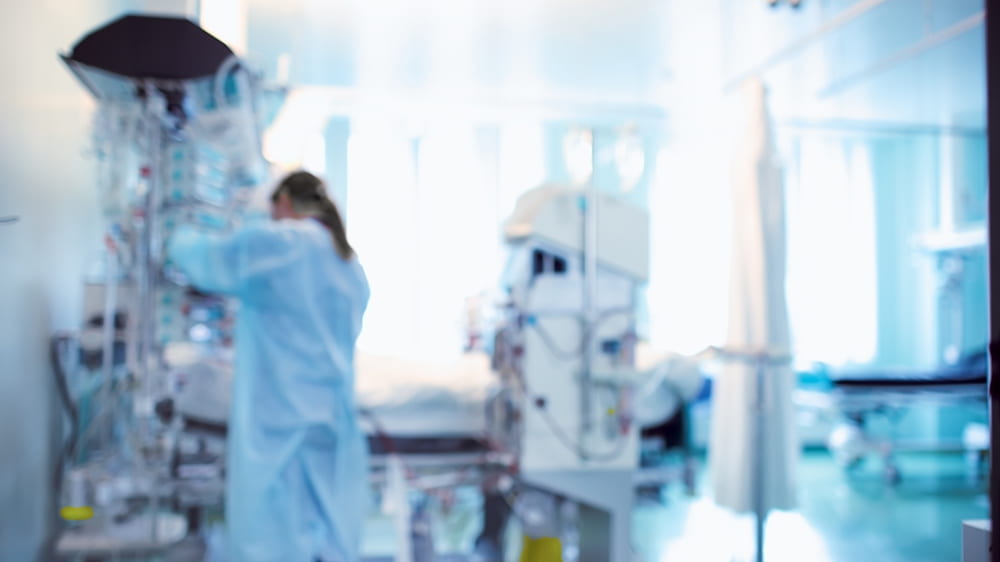
Oct 21, 2020 | Microbiome
by Elise Wachspress
Aside from the obvious, COVID-19 has taught us a lot of things we might never have thought would interest us. Now we all know what Zoom is (even if we don’t know who might be wearing pajama bottoms). We know how Instacart works and that Amazon delivers toilet paper. We get the basics of making face masks and the safest materials to use. Even the Oxford English Dictionary is pointing out words surging in usage after decades of disuse.
For better or worse, we also now know a lot more about intensive care units. Some of us might have been familiar with surgical ICUs, when friends or family needed special post-operative care. But the many media stories about COVID have brought us—intellectually—into medical ICUs, for patients who need long-term, intensive observation and treatment. We’ve heard endless reporting of the many machines, monitors, ventilators, tubes, and wires involved, and stories of the armies of medical professionals treating those who are critically ill.
But the tiniest players in the ICU—short of the virus itself—can be overlooked. The microbes that live within us are major factors in keeping us healthy, and nowhere is understanding their involvement more important than in the ICU.
Critically ill patients are often those most at risk for alterations in their microbiome. Unlike surgical patients, who come into the hospital with digestive systems largely intact, patients admitted to the medical ICU have likely been under stress for a while, with perhaps major changes in diet and treatment with multiple medications which expand in the ICU.
Among these treatments, antibiotics are the most disruptive to the microbial community, killing off good bacteria along with the problematic ones and further unbalancing the microbial diversity that supports good immune function and health. Once that harmony is upset, those bacteria that are left may pump out metabolites—end products—that seriously compromise the chemistry of the entire gut and exacerbate the patient’s illness.
Then the really bad microbes, those resistant to antibiotics, can take over. Resistant bacteria can invade the blood stream via compromised gut tissue and spread to the bloodstream and throughout the body, potentially leading to sepsis.
When a patient has an infection serious enough to land in the ICU, antibiotics may be absolutely necessary. But by understanding the mechanics of these microbial interactions, intensivists can provide better, more nuanced care.
John P. Kress, MD, is an intensive care specialist widely recognized as an innovator in his field. He was among the first in the US to demonstrate that helmet-based respiratory assistance was often more effective—and less distressing—than intrusive ventilators for some ICU patients. So it is no surprise that he is actively investigating how treatments in the ICU affect and are affected by the patient’s microbiome—and how managing this balance can improve outcomes.
With his postdoctoral fellow, Matthew Stutz, MD, Kress’s team are providing stool and blood samples collected during the ICU stay to Duchossois Family Institute Director Eric Pamer, MD. The DFI team is studying the bacterial composition of each, looking for correlations over time.
How does the microbial balance correlate with the development of sepsis? Can certain bacteria found in the stool or blood predict the length of ICU stay or the need for a ventilator? Do changes in the microbiome track readmission to the ICU or mortality? Do the microbes present affect the patient’s function and strength after discharge, including long-term cognition and mental health?
As with most studies, this one will involve a lot of data-crunching. To the huge amount of information collected on each ICU patient–vital signs; clinical notes; lab, microbiology, pathology, pharmacy, and respiratory support reports—the DFI team will add vast stores of genomic data on the bacteria they find. The team will also integrate evaluations of long-term outcomes like functional status, cognition, and mental health for a year after discharge from the ICU.
Enrolling patients in this study will be somewhat complicated: close to 40 percent of patients admitted to the ICU may not be conscious enough to provide truly informed consent. Fellows like Dr. Stutz will need to carefully explain the study to distraught family members who hold the patient’s power of attorney, with the assurance that patients can always opt out of the study at a later date.
But Kress and his team agree that the ongoing coronavirus pandemic offers an exceptional opportunity. The team can both identify changes over time in the microbiota of patients in the ICU with any illness and compare these to patients isolated in intensive care for COVID-19. This study may lend greater clarity in treating—and saving—patients seriously ill from this novel virus.
Because of the large number of patients treated in UChicago Medicine’s medical ICU, the team has been enrolling about 50 patients a month. Their goal of studying 500 patients over the next year would make this the largest study ever of the effect of the microbiome in the intensive care unit. By generating insights into patients’ “inner allies,” they can better restore health to these most vulnerable patients.
Elise Wachspress is a senior communications strategist for the University of Chicago Medicine & Biological Sciences Development office

Oct 7, 2020 | Microbiome, Transplantation
by Elise Wachspress
Imagine you need a new heart to survive.
First, there is the drama of waiting for a donor heart that is a good match—knowing that your chance at life depends on someone else losing theirs.
Then, there is the actual surgery—having your chest opened and an entire team implanting this new organ, followed by both the euphoria of success—one year survival rates are now over 85 percent—and the realization that rehabilitation will require strength of body, mind, and will.
Next comes an intense drug regimen to protect your new heart from being rejected by your body’s immune system. The early danger is that your body’s specialized T-cells will attack the new heart itself. Over the past few decades, transplant specialists have developed a number of strategies to tamp down these cellular incursions, balanced with vigorous antibiotic management to address opportunistic infections. So your chances of thriving through this early stage are strong.
Yet even with a carefully calibrated drug regimen, a significant number of patients still fall prey to serious problems later, especially later during the first five years after surgery. Most common is a condition known as cardiac allograft vasculopathy (CAV). In CAV—known as the Achilles heel of heart transplantation—fibers grow down the inside of the cardiac artery wall, thickening the vessels, not dissimilar to how old galvanized pipes in a home’s plumbing eventually corrode and slow the flow of water to a trickle. Though this kind of thickening can happen in other types of cardiac disease, it progresses much more quickly in patients with heart transplants and often leads to failure of the graft.
Transplant specialists like Ann Nguyen, MD, have suspected for a while that CAV results from an attack not by the body’s immune cells, but by immune proteins—antibodies—circulating in the blood. Growing evidence suggests that certain sensitizing events, like a blood transfusion or pregnancy, can cause the body to create new donor-specific antibodies. Fewer than 10% or so of patients have these antibodies before transplant, but up to three times that many develop these antibodies afterward, and their presence can increase the odds of a failed heart graft fivefold.
Nguyen and her fellow, Mark Dela Cruz, MD, have been following the work of Duchossois Family Institute Director Eric Pamer, MD. His research has shown that certain gut microbes can protect against infections in patients receiving a bone marrow transplant and that bacterial diversity in the gut decreases mortality after the transplant. Nguyen and Dela Cruz are interested in understanding how a patient’s individual microbiome might affect the production of donor-specific antibodies and the outcomes patients experience after heart transplants.
To do so, they have designed an observational clinical study, with one fairly simple change in each patient’s regimen: the addition of one more type of sample—stool—to the blood and urine samples normally collected to monitor patients before and for months after heart transplant. The stool samples will allow Pamer and the DFI team to assess the patient’s microbiome before surgery and track any changes after transplant. They will then correlate what they learn about each patient’s microbiome with the progress of their cardiac transplant for at least the first two years after each patient’s transplant.
UChicago is extremely well-positioned to conduct this study. Not only does the University of Chicago Medicine perform 40 heart transplants per year—with the best survival rates in the state—but the DFI provides facilities for microbial characterization and study matched by few other research centers. Nguyen and Dela Cruz aim to enroll as many patients as possible within one year.
With what they learn about the microbiome’s effects on long-term success after cardiac transplant, they hope they can keep transplanted hearts beating healthily for many more years.
Elise Wachspress is a senior communications strategist for the University of Chicago Medicine & Biological Sciences Development office

Jun 8, 2020 | Bioinformatics, Immunology, Microbiome
by Elise Wachspress
If you hang out with cutting edge scientists, you might hear or see the word (the suffix? a crossword puzzle answer?) “omics.” What are omics?
More than likely you‘ve heard of genomics, the study of the structure, function, evolution, and mapping of genomes, the collection of all the DNA in each organism.
And perhaps you’ve heard of transcriptomics, the study of all the ways an organism’s DNA is “transcribed,” or written into smaller molecules, the RNAs. While the DNA provides the basic, relatively unchangeable blueprints, environmental needs in the cell prompt the activation of specific genes. It’s like the highway engineer who, using her part of the blueprint, stages and directs the construction of one of the on-ramps. She’s working in concert with the larger plan, but somewhat separately from those directing other parts of the project.
Then there’s proteomics, the study of the structure and function of all the proteins that carry out the business in the cells. If the genome is a blueprint, and the engineering crew the RNA, the proteins are the molecular machines and building blocks—the backhoes, drills, and concrete—used to carry out the design.
The newest of the ‘omics fields is metabolomics: the study of all the chemical outputs of our cells and every microorganism that lives in and on us. These molecules, taken together, reflect the entire, functioning system, like how the cars and trucks using the highway are moving and thus creating new capital for society. Metabolomics is something like Here or Google maps, measuring important indicators of how the system is performing at both the street and system level. In a biological system, a genome can tell you what is possible, but the metabolome tells you what is actually happening.
But these readouts are more complex and critically useful: how a particular drug is working, how our immune system is responding, how microbes inside us are contributing to our health or modifying their environment to outcompete others, or even how our brains are prompting our bodies to act, and vice versa. New metabolomics technologies can help scientists non-invasively identify disease biomarkers, discover microbial products that can become new drugs, and identify the safest, most efficient ways to maintain health.
Among the many important resources the Duchossois Family Institute (DFI) is developing at UChicago is a facility that specializes in metabolomics. Led by Jean-Luc Chaubard, the DFI Host-Microbe Metabolomics Facility will feature state-of-the-art mass spectrometry, a powerful analytical technique that can be used to detail the profile of complex mixtures, whether solid, liquid, or gas. With this and other advanced instrumentation, DFI scientists will be able to understand the balance of molecules in blood, plasma, saliva, fecal, and even tissue samples, as well as in the waste products left behind when microbes are cultured (grown) outside the body.
Chaubard and his group will be looking at many things: from neurotransmitters and amino acids to bile acids and short-chain fatty acids, recently identified as critical to a healthy immune system. They will use large chemical libraries to create specialized “panels” that can profile multiple metabolites simultaneously. With these capabilities on campus, individual investigators will have ready access to new assays tailored specifically to their work.
The Metabolomics Facility will also help DFI investigators hone experimental design, decide when and how best to collect and store samples, and prepare those samples for testing. Importantly, they will also help in the data analysis that is critical in massive data-collection regimens like mass spec.
Chaubard, with a background both in academia (at Memorial Sloan Kettering and Caltech) and business (as founding director of the Molecular Discovery Lab at Modern Meadow, in New Jersey) is up for the challenge. An entrepreneur at heart, he is excited to be launching a resource that will set up UChicago as a leader in studying the convergence of immunology, the microbiome, and human health: “Here at UChicago, I get to work with some of the best scientists and doctors in the world, translating their work into practical applications that range from mechanistic understanding of human biology to early disease detection and discovery of novel drugs. It’s an honor to have this opportunity to improve the human condition.”
The Metabolomics Center is just one of the new platform resources made possible by a $100 million gift from The Duchossois Family Foundation and Craig and Janet Duchossois. We will bring you descriptions of several more in the weeks to come.
Elise Wachspress is a senior communications strategist for the University of Chicago Medicine & Biological Sciences Development office.

Apr 13, 2020 | Immunology, Microbiome
by Helen Robertson
In 1933, identical twin baby boys Oskar Stohr and Jack Yufe were separated as a consequence of their parents’ divorce. Their subsequent upbringings could not have been more different: Oskar was brought up as a Catholic in Germany and became an enthusiastic member of the Hitler Youth. Jack remained in the Caribbean where they were born, was Jewish, and even lived for a time in Israel. Yet when they were reunited some fifty years after they last saw each other they had an uncanny number of similarities. They shared thought patterns, walking gait, a taste for spicy food, and perhaps most unusually, a habit of flushing the toilet before using it.
The unfortunate separation of identical twins provides scientists with an exceptional laboratory for exploring the “nature vs nurture” conundrum. How much of our identity is conferred by our genes, and how much is a product of the environment in which we are raised? This is also true for our microbiome: twin studies have shown that the microbiomes of identical siblings are far more similar than those of fraternal twins, indicating that genes are at play.
UChicago researchers Alexander Chervonsky, PhD, and Tatyana Golovkina, PhD, are particularly interested in exploring how genetics—especially the genes that control our immune system— influence the composition of our microbiome. They chose to explore this question with mice.
Both mice and humans have two types of immunity: innate, “inborn” immunity, the first line of defense against pathogens, and adaptive immunity, in which immune cells are trained by the specific pathogens they encounter to fight off the same bad guys in the future.
To make sure all the mice used in the study started with the same microbes, Chervonsky and Golovkina needed to isolate them from the regular, bacteria-filled world. A normal mouse—much like a normal human—is born into an environment with trillions of bacteria, spread to them from their mothers and cagemates, their handlers, bedding, and food. Fortunately, UChicago’s special germ-free “gnotobiotic” mouse facility allows scientists to experiment on mice born and raised in an environment that hosts precisely zero bacteria, which make the mice experimental blank slates.
The researchers transferred microbes from a source mouse, raised in a conventional environment, to several strains of germ-free mice: some genetically identical, others with slight differences in their immune-response genes. In collaboration with computational immunologist Aly A Khan, PhD, they compared the resulting microbiomes to see if changes to immune system genes resulted in different types of microbial communities.
They found that differences in the adaptive—targeted—immunity caused minimal differences in microbial composition, and that those differences affected only certain strains of bacteria. Other types of bacteria even took advantage of the genetic differences and multiplied.
The team was surprised to discover that it was the innate immune response—the one the mice were born with, that needs no training: it was more active in shaping the microbiome. But even then, the total influence over the microbes in the mice’s gut was fairly small, meaning there were likely other genetic and non-genetic factors at play in determining how bacteria colonized and proliferated in the animals guts.
The team intends to look deeper into understanding how genes and microbes influence each other in developing animals. But this study sets a valuable benchmark for future microbiome work: closely documenting how the immune system worked here in germ-free mice means comparisons against other studies are standardized. Now we have a better idea of the “nature” side of the equation.
The Gnotobiotic Research Animal Facility is a vital asset for researchers at UChicago, and just one example of the gold standard approaches being used by the Duchossois Family Institute to improve our understanding of the underlying components of health and wellness.
Helen Robertson is a postdoctoral scholar in Molecular Evolutionary Biology at the University of Chicago, with a keen interest in science communication and science in society.

Jan 22, 2020 | Microbiome, Neuroscience
by Helen Robertson
What is your biggest concern about growing old? A decline in physical fitness? A loss of independence? Or perhaps it’s the fear that your mental fitness might start to lose its edge?
For the 50 million people worldwide living with dementia, that last scenario is a reality. A dementia diagnosis comes with big personal, social, and financial consequences: the cost of care for someone living with dementia is reportedly higher than that of both heart disease and cancer combined.
The most common cause of dementia in the US is Alzheimer’s disease. Although its symptoms are well known—cognitive decline, neuroinflammation, and the tell-tale formation of amyloid plaques, the hard aggregation of proteins between nerve cells in the brain—the precise cause remains unknown, and there is no current cure.
As the world population continues to age, dementia is increasing. The need to uncouple its complex biological processes is urgent.
Sangram Sisodia, PhD, has spent the past three decades investigating just that. But in recent years his Alzheimer’s research has taken an exciting and unexpected focus: the gut.
Thanks to recent findings, many of them by research teams at UChicago, we have learned that the bacteria living in our guts can affect many aspects of health. Normally, our gut microbiome contributes to everyday wellbeing and immunity. But just like any other community, the composition of our microbiome can fluctuate on a near-daily basis. And when a shift in balance occurs, things can go awry.
Our intestinal microbes have a particular influence on immunity and neurological function, both important factors in Alzheimer’s. Those with the disease have also been found to experience a change in the character of their gut microbiome.
That’s where Sisodia stepped in.
Over the past few years, his team has been using mouse models of Alzheimer’s to understand how the composition of our gut microbiome might influence neurological inflammation caused by certain immune cells. They thought this inflammation could contribute to both the protein deposition and neurodegeneration in Alzheimer’s.
Sisodia’s research has already generated some interesting findings. His studies, published in Scientific Reports and the Journal of Experimental Medicine, showed that the long-term treatment of mice with broad-spectrum antibiotics reduced neuroinflammation and slowed the growth of amyloid plaques.
After treatment, the mice also showed significant changes in the composition of their gut microbial communities. Some types of bacteria completely disappeared; others multiplied—suggesting bacterial diversity in the gut plays a role in the immune response during disease progression.
But only for male mice. In females, antibiotics actually increased the inflammatory response, with no change in brain plaques. With Alzheimer’s more prevalent in women than men, this gender difference in immune response clearly warrants more study.
Myles Minter, postdoctoral scholar in Sisodia’s lab who is now a research analyst at William Blair, wondered what might happen if one could prevent Alzheimer’s by treating it early—really early. He gave two-week-old mice pups antibiotics for just one week—which left lifelong effects on both their gut microbiome and amyloid plaque formation.
But this is no simple solution. UChicago neonatologist Erika Claud has shown how changes to the microbiome of premature babies can have a negative impact on neurological development, and Eugene Chang found mouse pups whose mothers were treated with antibiotics were more likely to develop inflammatory bowel disease.
Constantly treating individuals with antibiotics is not a realistic scenario, even for those with genetic predisposition for Alzheimer’s, but Sisodia is keen to investigate further. He has recently been awarded a grant of over $2,000,000 to continue his research into Alzheimer’s disease and immunity. The money comes from the Good Ventures project, involving Massachusetts General Hospital, University of Southern California, Northwestern University and Washington University, with total funding over $10,000,000. The hope is this collaboration can uncover mechanisms at play between our microbiome, our immune system, and Alzheimer’s disease.
This is just another example of how the microbiome offers keys for exploring new preventative and treatment approaches for healthy longevity. As Bette Davis once suggested, “Old age ain’t no place for sissies,” but maybe someday losing our mental fitness may not top our list of concerns about aging.
Helen Robertson is a postdoctoral scholar in Molecular Evolutionary Biology at the University of Chicago, with a keen interest in science communication and science in society.








